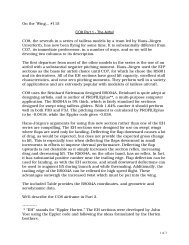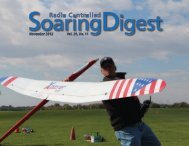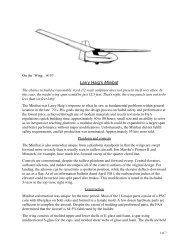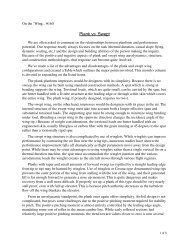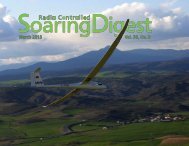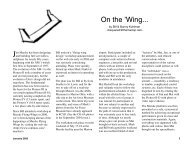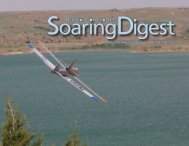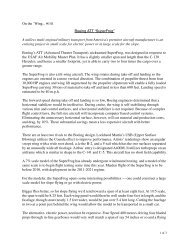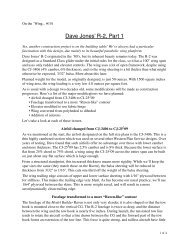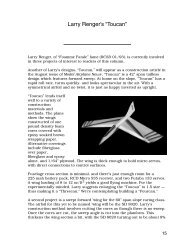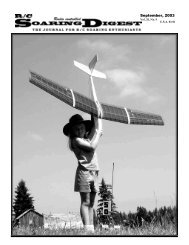Alula2 PDF - B2Streamlines
Alula2 PDF - B2Streamlines
Alula2 PDF - B2Streamlines
You also want an ePaper? Increase the reach of your titles
YUMPU automatically turns print PDFs into web optimized ePapers that Google loves.
36the shrink tubing must be of aslightly larger diameter thanthat used for the aileronlinkage. (Photo 4)Completed airframe Ourfaithful FMA Direct receiverwas placed in the reconfiguredslot, and one of Michael’s 210mAh NiMH battery packs wasinstalled up front. (Photo 5)On the balance stand (Photo 6)the completed airframe withall components installedrequired only 14 grams of leadto have the CG placed at thepoint recommended in theinstructions. As our previousAlula required 8 grams ofweight for the same balancepoint, this came as a pleasantsurprise.The overall weight, ready tofly, is 4.8 ounces (136 grams).This compares quite favorablywith the original Alula whichflies extremely well at 4.4ounces.(124 grams).Because we decided to notcolor the wing bottom surfaceafter all, the includedphotographs have morerecognizable detail than wouldotherwise have been inevidence. We’re still workingon getting some sort offuselage covering put on.R/C Soaring Digest 5
Rather than make the Mixtrims active, we left thosesettings on INH (inhibit).With this setting we can adjustthe neutral of either aileronindependently from the other.<strong>Alula2</strong> is currently flying withthe ailerons exactly lined upwith the elevator. Launcheshave just a hint of a climb, andit can cover a surprisingdistance with good cruisespeed and a low sink rate.Control throws Our originalAlula uses the recommendedelevon control throws —elevator 4-5 mm total, aileron10-12 mm total. <strong>Alula2</strong> canuse elevator throws 5-7 mmup and 4-5 mm down; aileronthrows can be set for 5 mm to10 mm with no differential.We usually fly with the lowerelevator setting and a middleaileron setting which gives 7mm travel up and down.This means we’re using thesame elevator deflection andslightly less aileron deflectionthan recommended for theelevon version.Launching Progressing fromlight hand toss to full powerSAL took only a few trim clickson the transmitter and nochange in CG location.Comparisons So, how doesthis modified Alula fly? In aword, “Fantastic!”We now have over 400 flightson the airframe, and it’s beenpiloted by an ever growingnumber of fellow SASSmembers as well as ourselves.The roll rate is fairly rapid, butis still fine enough that fourpoint rolls are possible.In an impromptu “contest,”pilots found two vertical rollsafter launch to be pretty easy,three somewhat difficult butnot impossible. With a truediscus throw (the kind whereall of the blood in your armgoes to your hand) we’re fairlysure you could get four.Our first Alula has thetendency to run out of elevatorauthority as the angle of attackincreases. When this happens,the nose drops slightly and anyturn quickly straightens out.The aircraft then drops downat about a 30 degree angle withthe fuselage about level withthe ground.It is also possible to apply alittle less up elevator andwitness a rapid bobbing inpitch due to stall hysteresis.The <strong>Alula2</strong> behaves in similarfashion, but everythinghappens in a much morepredictable manner. Majordifferences? <strong>Alula2</strong> flies moresmoothly and has better “legs”when covering distance.Jason Brinley, a fellow SASSmember, had just completedhis Alula when we met withhim at 60 Acres. Jason usestwo servos which drive fullspan elevons, as per standardpractice. He was having agrand time with his 4.3 ounceAlula, flip-flopping it aroundlike a 3-D electric, doing pylonracing turns around willingcollaborators, and pretty muchhaving more fun than anyoneis entitled to have with a $50foamie.We let him fly our <strong>Alula2</strong> andhe was pleasantly surprised.While it won’t do all of thefancy (and sometimes erratic)maneuvers his is capable ofperforming, Jason says it’s asmooth flying airplane incomparison to his and will be agreat thermal machine.When flown together, Jason’sis very slightly slower and has abarely noticeable better sinkrate. Both of thesecharacteristics are to beexpected because of the slightweight difference and resultingwing loadings.Dave Beardsley, who has flownall manner of sailplanes,electrics, helicopters andaerobatic aircraft, definitelyprefers the <strong>Alula2</strong>, with itsseparate control surfaces, tothe elevon version. He says it isfar better in the areas ofpredictability and efficiency.Long term wear and tearissues Our original Alulanow has several hundredflights on it, and the tail beganslipping out by a very smallfraction of an inch on eachlaunch. The tail boom flexesquite a bit on launch, so this isprobably a matter of the boom“walking” out of the Coroplastsocket.This potential problem wasvirtually cured by rubbing beeswax on the carbon rods. Thisprovides just the right amountof stickiness to prevent theslipping, but it doesn’t at allaffect removal of the tail fortransport.9 R/C Soaring Digest
The Goop paint treatment hasdone an excellent job ofprotecting the fuselage.Gordy’s article points out thatone of the initial layers can bepainted or covered, and thenclear Goop applied over thecolored layer. We’d like to hearfrom anyone who has amethod for actually coloringthe thinned Goop, particularlyif the coloring can betransparent.Still experimenting Onetrick we’ve been fooling is theuse of the Snap Roll button onthe transmitter during theinitial climb phase afterrelease. When the Snap Rollbutton is depressed, theailerons are set for zerodeflection and the elevator isset to 8% down. This gives anabsolutely straight trajectoryuntil the button is released.Conclusions As you canprobably tell, we LOVE thisairplane! While the elevonversion flies extremely well,we feel the three servo option,with separate aileron andelevators functions, is both aviable and exciting alternative,especially if you’re a flat landflyer who wants to exploresmall newly formed thermalsrather than performmegaradical maneuvers on theslope. The three servo version,by all accounts from thosewho’ve flown it, is noticeablymore efficient whilemaintaining essentially thesame maneuverability.An Alula kit is $45 plus $5.50packaging and shipping fromMichael Richter at RichterR/C, .If you plan tobuild a three servo version,make sure you order a secondhardware set, too.The kit itself is quite complete,with all necessary hardwareincluded. Missing are tape,adhesives, and color. All youhave to do is construct theairframe and add your ownservos, receiver, and batterypack.We do suggest you purchase aroll of covering tape along withthe kit, however, as finding aroll of suitable lightweighttape on your own can be quitetime consuming.If you want to see the standardAlula in severe action, and insome interesting slope soaringenvironments, go toand download the “Pop Fly”QuickTime movie. This is alarge file (17.6 MB), but it’swell worth the download timerequired if you’re on dial-uplike we are.Brian Kloft recently visited theSeattle area on a business tripand spent several Wednesdayevenings at 60 Acres. Brianwas able to use his digital stillcamera in movie mode andcapture some video of our<strong>Alula2</strong> flying under the darkskies present at the time.We’ve placed two of thesevideos (MOV and MPG) on theRCSD web site. The URLs are:and.Is it possible to have too muchfun with an Alula? Wecertainly don’t think so.R/C Soaring Digest 10



